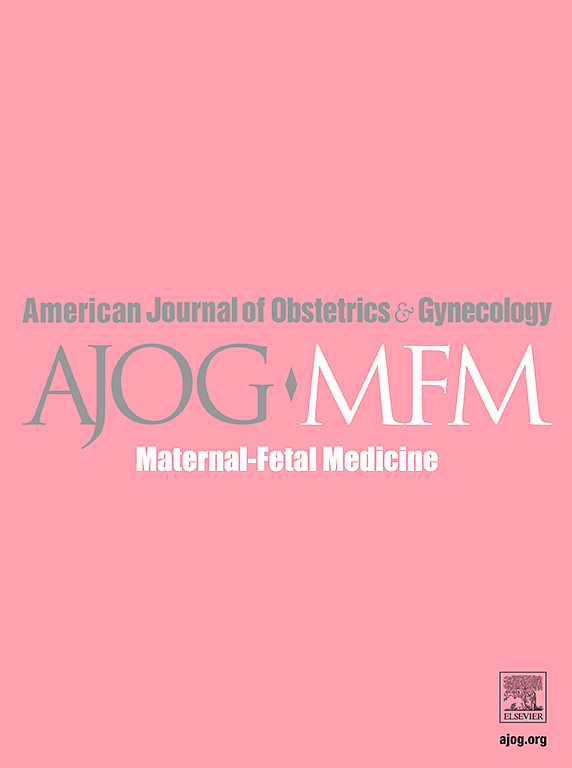IF 3.8
2区 医学
Q1 OBSTETRICS & GYNECOLOGY
American Journal of Obstetrics & Gynecology Mfm
Pub Date : 2025-01-27
DOI:10.1016/j.ajogmf.2025.101602
引用次数: 0
摘要
背景:PTB (PTB)仍然是新生儿发病和死亡的主要原因。在有自发性肺结核病史的单胎患者中,短宫颈长度(CL)≤25mm的宫颈环切术与新生儿发病率/死亡率降低相关。阴道孕酮和环扎术均有1级证据支持对合并短胎径的妊娠患者预防PTB的益处,但对于无自发性PTB史的短胎径≤25mm的单胎患者,环扎术与孕酮单独使用相比的潜在益处缺乏1级证据。目的:我们旨在开展一项实用的随机对照试验,以评估阴道孕酮环扎术与单独阴道孕酮对无自发性PTB且目前妊娠中期经阴道超声(TVU) CL≤25mm的单胎患者的额外益处。研究设计:这是一项多中心国际随机对照试验,于2017年9月至2023年9月在美国和意大利的四个地点进行。无自发性肺结核的单胎妊娠在妊娠中期解剖超声检查中接受TVUCL(普遍)筛查作为常规护理的一部分。纳入标准为18 0/7 ~ 23 6/7周时TVUCL≤25mm。排除标准包括目前或计划的宫颈环扎、宫颈扩张、分娩症状、感染、出血、筛查时的膜破裂。参与者按1:1随机分为阴道黄体酮环扎术(每天200mg阴道黄体酮)或单独阴道黄体酮环扎术;随机分组按研究地点和TVUCL≤15mm进行分层。主要结局是PTBResults:招募时间为2017年9月22日至2023年10月31日,由于招募滞后而提前停止。93名受试者随机分组,其中3名因戒断(n=1)和无法随访(n=2)而被排除。在90例纳入意向治疗分析的患者中,43例使用环扎术和黄体酮,47例单独使用黄体酮。总体而言,40例(40.4%)患者的TVUCL≤15mm。结论:在未发生自发性PTB的单胎妊娠中,24周前TVU CL≤25mm,与单独使用孕酮相比,孕酮结扎术并没有发现显著降低PTB发病率,但确实导致从随机分配到分娩的潜伏期明显延长,分娩时的胎龄明显延长。这些结果表明,与单独使用黄体酮相比,环扎术和黄体酮在24周前没有自发性PTB且宫颈长度短≤25mm的单胎患者中有潜在的益处。该试验提前终止,这些发现应在更大规模的试验或荟萃分析中得到证实。摘要:在宫颈短且既往无自发性PTB环切的单胎患者中,与单独使用黄体酮相比,黄体酮不能降低PTB的发病率;但是那些有环扎和黄体酮的人的分娩潜伏期和分娩胎龄增加。该试验提前终止,需要更大规模的临床试验或荟萃分析。本文章由计算机程序翻译,如有差异,请以英文原文为准。
Cerclage in singleton pregnancies with no prior spontaneous preterm birth and short cervix: a randomized controlled trial
BACKGROUND
Preterm birth remains a leading cause of neonatal morbidity and mortality. Cerclage for short cervical length ≤25 mm in patients with singleton pregnancies with a history of spontaneous preterm birth is associated with decreased neonatal morbidity/mortality. Both vaginal progesterone and cerclage individually have level 1 evidence supporting benefit in the prevention of preterm birth in pregnancies complicated by short cervical length. However, there is a paucity of level 1 evidence regarding the potential benefit of cerclage with progesterone relative to progesterone alone for short cervical length ≤25 mm in patients with singleton pregnancies without a history of spontaneous preterm birth.
OBJECTIVE
This study aimed to conduct a pragmatic randomized controlled trial to evaluate the additional benefit of cerclage with vaginal progesterone relative to vaginal progesterone alone in patients with singleton pregnancies without prior spontaneous preterm birth and with a current midtrimester transvaginal ultrasound cervical length ≤25 mm.
STUDY DESIGN
This was a multicenter international randomized controlled trial conducted from September 2017 to September 2023, involving 4 sites in the United States and Italy. Patients with singleton pregnancies without prior spontaneous preterm birth received transvaginal ultrasound cervical length (universal) screening during the midtrimester anatomy ultrasound examination as part of routine care. Inclusion criteria included transvaginal ultrasound cervical length ≤25 mm at 18 0/7 to 23 6/7 weeks. Exclusion criteria included current or planned cerclage, cervical dilation, symptoms of labor, infection, bleeding, and rupture of membranes at screening. Participants were randomized in a 1:1 ratio to cerclage with vaginal progesterone (200-mg vaginal progesterone daily) or vaginal progesterone alone. Randomization was stratified by study site and transvaginal ultrasound cervical length ≤15 mm. The primary outcome was preterm birth <35 weeks, assessed using intention-to-treat analysis. Secondary outcomes included preterm birth <37, 32, 28, and 24 weeks, gestational age at delivery, latency to delivery, and neonatal outcomes. Categorical variables were compared using the Pearson chi-square test and relative risk estimates with 95% confidence intervals. Continuous variables were compared using the Mann–Whitney U test. Latency to delivery and gestational age at delivery were also compared using Kaplan–Meier survival curves. Planned enrollment was set at N=206 on the basis of an estimated 0.54 relative risk with cerclage and a 34% incidence of preterm birth with standard care. The trial was registered on ClinicalTrials.gov (NCT03251729) on June 22, 2017.
RESULTS
Enrollment ran from September 22, 2017 to October 31, 2023, and was halted early because of lagging enrollment. A total of 93 participants were randomized; 3 were excluded because of withdrawal (n=1) and loss to follow-up (n=2). Of the 90 participants included in the intention-to-treat analysis, 43 were assigned to cerclage and progesterone and 47 to progesterone alone. Overall, 40 participants (40.4%) had a transvaginal ultrasound cervical length ≤15 mm. There was no significant difference in the primary outcome of preterm birth <35 weeks between those randomized to cerclage with progesterone vs progesterone alone (16.3% vs 23.4%; relative risk, 0.70 [0.30–1.63]). Those randomized to cerclage with progesterone had significantly increased latency from randomization to delivery (median difference, 13 [5–20] days; P=.01) and a significantly later gestational age at delivery (median difference, 1.0 [0.2–1.7] weeks; P=.035). A Kaplan–Meier survival curve also demonstrated increased latency to delivery and gestational age at delivery for cerclage with progesterone compared with progesterone alone (Mantel–Cox log-rank P<.001 and P=.003, respectively). These findings persisted within both subgroups of cervical length ≤15 mm and 16 to 25 mm.
CONCLUSION
In singleton gestations without a prior spontaneous preterm birth and a transvaginal ultrasound cervical length ≤25 mm before 24 weeks, cerclage with progesterone was not found to significantly reduce the preterm birth rate compared with progesterone alone. However, cerclage and progesterone did result in a significantly longer latency from randomization to delivery and a significantly later gestational age at delivery, compared to progesterone alone. These results suggest the potential benefit of cerclage and progesterone relative to progesterone alone in patients with singleton pregnancies without a prior spontaneous preterm birth and a short cervical length ≤25 mm before 24 weeks. This trial was halted early, and these findings should be confirmed in a larger trial or meta-analysis.
求助全文
通过发布文献求助,成功后即可免费获取论文全文。
去求助
来源期刊

American Journal of Obstetrics & Gynecology Mfm
Medicine-Medicine (all)
CiteScore
7.40
自引率
3.20%
发文量
254
审稿时长
40 days
期刊介绍:
The American Journal of Obstetrics and Gynecology (AJOG) is a highly esteemed publication with two companion titles. One of these is the American Journal of Obstetrics and Gynecology Maternal-Fetal Medicine (AJOG MFM), which is dedicated to the latest research in the field of maternal-fetal medicine, specifically concerning high-risk pregnancies. The journal encompasses a wide range of topics, including:
Maternal Complications: It addresses significant studies that have the potential to change clinical practice regarding complications faced by pregnant women.
Fetal Complications: The journal covers prenatal diagnosis, ultrasound, and genetic issues related to the fetus, providing insights into the management and care of fetal health.
Prenatal Care: It discusses the best practices in prenatal care to ensure the health and well-being of both the mother and the unborn child.
Intrapartum Care: It provides guidance on the care provided during the childbirth process, which is critical for the safety of both mother and baby.
Postpartum Issues: The journal also tackles issues that arise after childbirth, focusing on the postpartum period and its implications for maternal health. AJOG MFM serves as a reliable forum for peer-reviewed research, with a preference for randomized trials and meta-analyses. The goal is to equip researchers and clinicians with the most current information and evidence-based strategies to effectively manage high-risk pregnancies and to provide the best possible care for mothers and their unborn children.
 求助内容:
求助内容: 应助结果提醒方式:
应助结果提醒方式:


